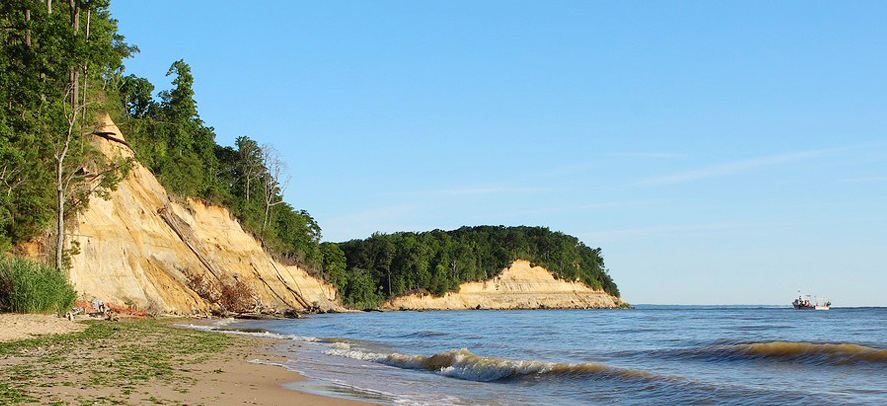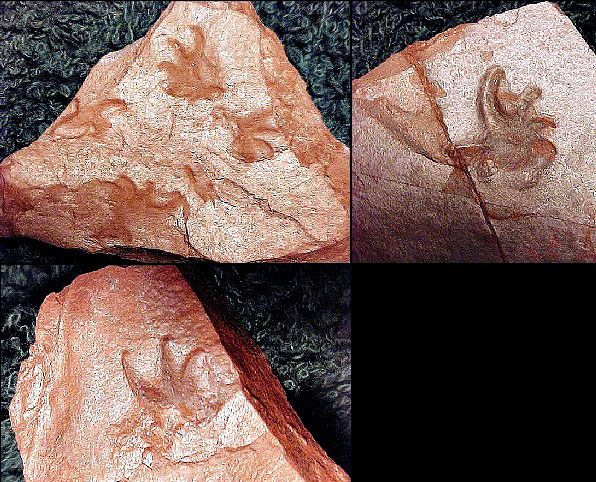
Fossil Collecting in Maryland

Part 1: From the Bay to Frederick
During the course of hundreds of millions of years, the land that comprises Maryland had undergone countless transitions, from being located under oceans to being locked up in a mountain chain as high as the present-day Himalayans.
In the beginning, after billions of years of “cooling off” following its creation, Earth was initially an oceanic planet, with the first-known land mass to rise above the ocean some 3.2 billion years ago.
Maryland’s oldest “window in time” can be found in the Blue Ridge Mountains, which have been dated around 1.1 billion years old. But don’t bother looking for signs of prehistoric animals among them. Traces of any life that might have existed then would have long been eradicated through metamorphosis—a rock-altering process, which would have destroyed any fossils that might have existed.
Calvert Cliffs
One of Maryland’s most renowned fossil sites is those of the Calvert Cliffs (also known as Scientists Cliffs) of the Western Shore of the Chesapeake Bay. In fact, the first fossils described from North America were collected from these cliffs.
Prior to the mid-1970s, there were many publicly accessible fossil sites within the 25-mile length of the cliffs. However, today, collecting is permitted only within a small portion of the series of cliffs, this being specifically within the confines of the Calvert Cliffs State Park.
The fossils contained within the cliffs range from 15 to 20 million years of age and were deposited in a sea that covered much of eastern Maryland, during a period of time known as the Miocene Epoch.
This was a time when 60-foot Great White sharks patrolled the Maryland shoreline, sharing their habitat with over 600 species of other prehistoric animals, including other sharks and rays, whales, porpoises, fish, marine crocodiles, sand dollars and sea urchins, coral, sponges (the writer of this article discovered the first fossil sponges—which also represented two new species—reported from the cliffs, which were presented to the Smithsonian Institute), mollusks (which include snails and clams and other types), and crabs.
Non-marine fossils are sometimes encountered, such as sea birds. Even prehistoric elephant teeth and other land mammals whose remains were washed into the sea via rivers have been encountered.
To arrive at the Calvert Cliffs State Park (CCSP), take Route 2/4 south to approximately 14 miles south of Prince Frederick. Exit onto H.G. Trueman Road, where the park entrance is located. Once at the park, the shortest route to the fossil-bearing beach is the 1.8-mile Red Trail, according to the CCSP.
There is a fee to collect at the beach, which is $5.00 per vehicle ($2.00 additional for out-of-state residents); $10.00 for a small bus; and $20.00 for a large bus. Parking fees must be paid in cash only.
Fossils may only be collected on the beach. Digging in the cliff is prohibited for safety reasons (and to prevent landslides and washouts).
For additional information, contact the Calvert Cliffs State Park at 443-975-4360.
Dinosaur Park
Around 155 million years ago, during a period of time known as the Early Cretaceous, Prince George’s County was covered with freshwater wetlands adjacent to an ancient river, which was inhabited by early dinosaurs.
The present day remains represent several types of Early Cretaceous dinosaurs that have been found in the Early Cretaceous of Maryland. (Don’t expect to run across a Tyrannosaurus rex—the dinosaurs found here are 50 million years older than the Tyrannosaurus rex).
The park allows supervised digging, overseen by an on-site paleontologist (one who studies prehistoric life). However, there is a catch. Those finding dinosaur remains during the dig are not allowed to keep what they find.
However, according to the Dinosaur Park website, “Digging is prohibited by visitors. Instead, you will learn surface collection techniques used by paleontologists in the field. Your fossil discoveries help park paleontologists better understand the ancient world of Prince George’s County. All fossils are stored and preserved in our Dinosaur Park lab. If you find a significant fossil, your name is recorded with it! You will be forever immortalized in our museum collection.”
If one wants to merely enjoy a chance of finding a dinosaur fossil (most likely a tooth or a bone), this site could fulfill at least that much.
For more information on scheduled digs, contact the Dinosaur Park by email at [email protected], or by calling 301-627-1286.
For more information on collecting dinosaurs in Maryland, refer to Maryland Geological Survey Educational Series No. 6, Dinosaurs in Maryland by Peter M. Kranz free at mgs.md.gov/output/reports/ES/ES_6.pdf.
“Wildcatting” in Frederick County
During the early 2000s, the writer of this article discovered the largest early-dinosaur fossil site that had ever been found in Maryland. However, the 140-acre site is located on private land.
The 220 million-year-old fossils recovered from the site included hundreds of fossil reptile and insect tracks, millipedes, and even complete fish (scales and fins included).
The site represented mud flats preserved adjacent to a prehistoric lake (dubbed Lake Lockatong), which existed from Rocky Ridge, growing in size towards the northeast, as it sprawled through Pennsylvania, New Jersey, and into New York State. Some believe that this great lake had covered an area equivalent to the presently existing Lake Tanganyika in Africa, at some 20,000 total miles in size.
Although the public at large is not permitted to collect at the 140-acre site, several roadcuts exist from Rocky Ridge to Old Frederick Road, which have produced plant leaves and branches and the remains of freshwater clam shrimp, which were deposited in backwater eddies associated with the main lake located on the 140-acre site.
For those interested in trying their luck at finding one of these satellite sites, the roadcuts in the general area as noted have produced numerous fossils, specifically, plant fossils and freshwater clam shrimp have been found in a telltale greenish, silty shale.
When examining roadcuts, find a place to safely pull off the roadway and keep an eye out for traffic on any narrow roads. While digging, ensure that any chunks of shale or rock do not roll onto the roadway.
The first (and only) Late Triassic dinosaur tracks that have been found in Maryland came from an abandoned flagstone pit located just outside of the Emmitsburg Town Limits and had been found in the 1800s. The site is on private property, which at one point even had mounted security cameras along the road leading to the site, and the residence beyond.
But who knows. There could be (and likely is) one or more as yet undiscovered dinosaur-track-bearing sites lurking in Frederick County.
After all, Maryland has, paleontologically, been one of the most researched sites in the Mid-Atlantic, beginning back in the 1700s… and yet the largest Triassic dinosaur age fossil site was not discovered until the early 2000s!
The “Really Old Stuff”
Part 2 of “Fossil Collecting in Maryland,” which will appear in the November edition of The Catoctin Banner, will address fossil sites west of Frederick County.
The fossil sites west of Frederick County consist of layers of rock dating as far back as hundreds of millions of years ago, long before the dinosaurs existed, when the land comprising Maryland lay below the oceans and predate the formation of the Appalachian Mountains.

Photo Credit: Maryland Department of Natural Resources
